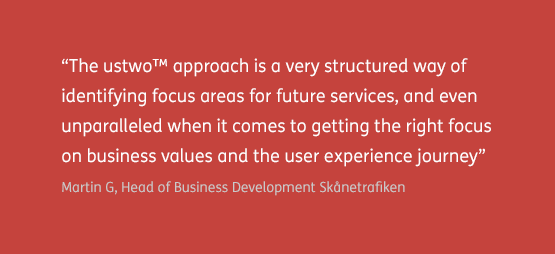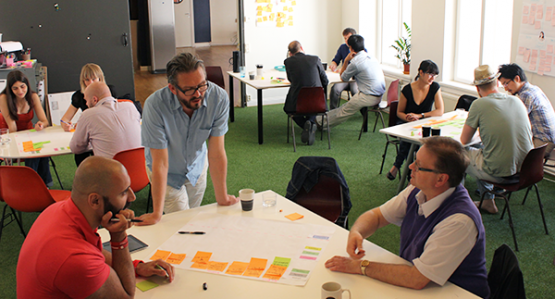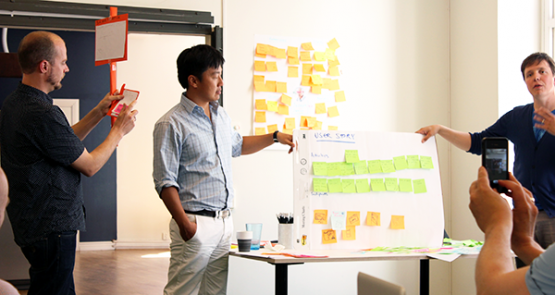When you have a pool of ideas for customer products and services, it can be difficult making sure you move ahead with the best ones.
We recently helped Skånetrafiken, the public transport supplier of southern Sweden, make this decision by pulling together a cross functional team (including the client) and running through a series of lean UX exercises with a JFDI mindset.
This process was extremely valuable to the client, creating some great concepts, as well as exploring new ways of looking at future business opportunities.
We always advocate tight collaboration with our clients to maintain maximum momentum and creative output when it comes to projects. For us, it’s all about JFDI and co-creation, as this drives ideas through to strategy, action and reality.
Firstly, what do you want to achieve?
It’s clear that without a cohesive strategy in place, evaluating ideas can be difficult. So to start this process it’s best to begin with a clean slate by deliberately forgetting (not forever) all previously discussed ideas and instead think about how the organization should serve its customer differently in the future. By agreeing on a direction or vision you will have a guide to base all future decisions going forward.
To achieve an aligned direction with the team at Skånetrafiken we organised a pre-meeting with a stakeholder group in order to get their input towards the vision of the project.
This vision was the starting point we used to kick off the lean UX exercises with the cross functional team. It was a highly interactive phase where both ustwo™ and Skånetrafiken jointly set out the direction for the project and its desired outcomes. In essence we explored how public transport would and could serve it customers in the future.
To define the vision further, it’s important to agree on what success is. How will you know you have succeeded? Define how these criteria for success will be measured and then make sure they are prioritized in order of importance.
Exercise: Define Desired Outcomes (one hour)
- On post it notes, each team member writes down the differences expected to be achieved after delivering the output over time.
- Organize team members into groups of 3-6 people by mixing designers and clients in each group.
- Ask each group to organize their post it notes into common themes.
- Each group presents their themes.
- Prioritize the themes.

Know your customers
Do you know who your customers are? Post a short description of your user types up on a wall for everyone to focus on. Select the user types (1-5 personas) you think potentially will contribute the most to your vision. Define who these personas are, what their needs and barriers are today. Prioritize the personas by order of importance.
Exercise: Personas (half hour)
- In the same groups.
- Give each group a persona to work with.
- Do empathy mapping for one persona per group.
- Each group presents their persona.
- Prioritize the personas.
Learn more about empathy mapping here.
Now you’ll need to explore each persona’s user journey; what activities, needs and barriers do you see before, during and after the persona’s experience with your organization/service. Map it out along a timeline.
Exercise: User Journeys (one hour)
- In the same groups keep working with the same persona.
- Write down the activities for the persona; before, during and after the persona’s experience with your organization/service on a timeline.
- Write down the needs the personas has during these activities.
- Each group presents their user journeys. Acting out the journey is encouraged.

Map the future
Once you’ve defined a vision and ways to measure success together with your primary personas and their journeys - it’s time to take all your new ideas that meet the needs identified, and mix them up with your previous ideas.
Prioritize the ideas by finding those that are contributing most to the vision by supporting the users and their journey towards your desired outcomes.
Exercise: Map Ideas (one hour)
- Each group brainstorms new ideas to support the needs of their persona through the user journey.
- Map all ideas to the user journeys.
- Prioritize ideas.
- Quickly prototype the best ideas.
- Each groups present their best ideas. Acting out is encouraged.
In essence what you have now is a set of prioritized ideas mapped to user journeys that together form the basis of one or more product or service. These can easily be translated into future-gazing scenarios.
After working through the above exercises in a cross functional team, we found that selecting the best ideas for Skånetrafiken was surprisingly easy, as each member was now aligned in thinking. This is one of the key reasons why workshops are so efficient - moving through many stages of the project in short time with a cross-company and cross-functional team reduces the overhead of summarizing and briefing.
Get your organization excited about the future
To help people outside the cross-functional team and in the organization as a whole understand the ideas and their purpose, you’ll need to find appropriate ways to communicate them. Be creative, make it visual. For example an image, a prototype, a video or a storyboard. Put the customer using the product at the centre of it all and show the value the service brings to them. In an upcoming blog post, we’ll tell you more about how we decided to communicate the ideas generated from the Skånetrafiken project.
Next - act on your vision
To be honest, what you have now is a hypothesis. A hypothesis about what products and services your customers will appreciate and that will lead to success for the organization. This hypothesis needs to be validated by iterating a “Build - Measure - Learn” loop. It’s all about prototyping and testing it with your customers to learn and adjust accordingly.
You can get a long way towards reaching your goals in just one workshop!